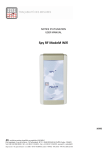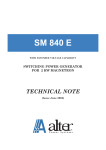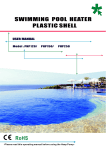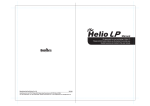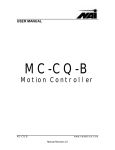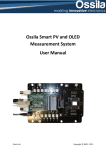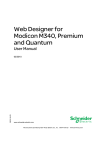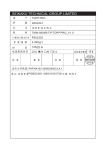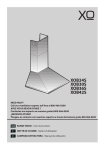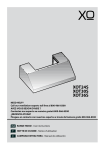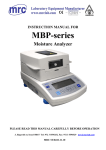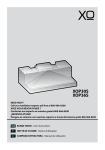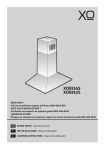Download Warning! - Autic system AS
Transcript
One H3 Series 0N3 H SERIES H3 User Manual Version 1.0 (Preliminary) © 2012 0N3 Srl All rights reserved Contents List Of Figures........................................................................................................6 Acronyms................................................................................................................1 General Information..............................................................................................3 1.1 Manual History..............................................................................................3 1.2 Manual organization......................................................................................3 1.3 Organization of safety notices.......................................................................3 1.4 Safety guidelines...........................................................................................4 1.4.1 Responsibilities......................................................................................4 1.4.2 Intended use..........................................................................................6 1.4.3 Protection against electrostatic discharges...........................................7 1.4.4 Transport and storage............................................................................7 1.4.5 Installation............................................................................................7 1.4.6 Operation main facts.............................................................................8 1.4.7 Supply voltage......................................................................................8 1.4.8 Emergency Stop push-button................................................................8 1.4.9 Enabling Device....................................................................................9 1.4.10 State Selector.....................................................................................11 1.4.11 Environmentally-friendly disposal.....................................................11 1.4.11.1.....................................................................................................12 Technical data.......................................................................................................13 2.1 Introduction.................................................................................................13 2.2 Selection guide............................................................................................15 2.3 Product coding.............................................................................................16 2.4 System overview.........................................................................................17 2.4.1 H3 terminal overview..........................................................................17 2.4.1.1 Ergonomics..................................................................................18 2.4.1.2 Housing .......................................................................................18 2.4.1.3 Operating and display field..........................................................18 2.4.1.4 Electronics....................................................................................18 2.4.1.5 Input devices...............................................................................19 2.4.1.5.1 Override potentiometers............................................................19 2.4.1.5.2 Handwheel (optional)................................................................19 2.4.1.5.3 Rubber keypad..........................................................................19 2.4.1.6 Interfaces to NC/PLC...................................................................20 2.4.1.7 USB interface...............................................................................20 2.4.1.8 Touch screen pen..........................................................................20 2.4.1.9 Safety related devices...................................................................21 2.4.2 Optional RFID TAG reader/writer.......................................................21 2.4.3 Connection box overview....................................................................23 2.4.4 Stand by Station...................................................................................23 4.5 Dimensions.............................................................................................24 2.4.5.1 Terminal.......................................................................................24 2.4.5.2 Connection Box............................................................................25 2.4.5.3 Stand by station............................................................................26 2.5 Technical data details...................................................................................27 2.5.1 Handheld terminal specifications........................................................27 2.5.1.1 Handheld terminal chemical resistance........................................29 2.5.1.1.1 Test results.................................................................................30 2.5.2 Cable connections................................................................................32 2.5.3 Cable connector specifications and pin-out.........................................34 2.5.3.1 DB25 connector pin-out...............................................................34 2.5.4 Safety-related devices..........................................................................35 2.5.4.1 Emergency Stop button................................................................35 2.5.4.2 Enabling device............................................................................35 2.5.4.3 State Selector................................................................................36 2.5.4.4 Details on the PL and SIL level of the safety related functions...36 2.5.4.4.1 Details on the PL (EN ISO 13849-1:2008)...............................36 2.5.4.4.2 Details on the SIL (EN62061:2005).........................................36 2.5.4.4.3 Parameters useful for the PL (EN ISO 13849-1:2008) and SIL (EN 62061:2005) calculation...................................................................37 2.6 Connection box cabling scheme..................................................................38 2.6.1 Cabling: H3 to Connection Box..........................................................39 2.6.2 Cabling: Connection Box to CN/PLC.................................................41 2.7 Stand-by-station Mounting tips...................................................................42 2.7.1 Mounting the wall mount Stand-by Station.........................................43 2.7.2 Mounting the Desktop mount Stand-by Station..................................44 2.8 Standards ....................................................................................................45 2.8.1 EC Directives.......................................................................................45 2.8.2 International Safety Standards.............................................................45 List Of Figures Acronyms CNC: Computer Numerical Control DC: Diagnostic Coverage DLL: Dynamic-Link Library ESD: Electrostatic Discharge HMI: Human-Machine Interface ISO: International Organization for Standardization TFT: Thin Film Transistor LCD: Liquid Crystal Display MDI: Manual Data Input MTTFd: Mean Time To dangerous Failure OS: Operative System PCB: Printed Circuit Board PLC: Programmable Logic Controller PLd: Performance Level Dangerous PLr: Required Performance Level SIL: Safety Integrity Level PUR: Polyurethane RGB: Red Green Blue R/W: Read/Write USB: Universal Serial Bus VDC: Volts of Direct Current XML: eXtensible Markup Language PN: Part Number SN: Serial Number 1 2 chapter 1 General Information 1.1 Manual History 1.2 Manual organization This user manual is inteded to give all kind of information regarding H3 handheld terminal. Chapter 1 is dedicated to general information, operation and safety main notices and an high level explanation of the device. Chapter 2 at first gives an overview to each component and then gives the detailed technical data. 1.3 Organization of safety notices All safety notices in this manual are specified as follows: 3 1.4 Safety guidelines 1.4.1 Responsibilities H3 handheld terminal is a small, light and comfortable remote system controller which, appositely configured and connected to a machine control logic and safety, guarantees machine control and configuration and the implementation of safety related functions. All configuration and control commands selected through the keyboard or the touch screen display, the optional handwheel and the potentiometers status are sent to the machine control logic through a serial or ethernet communication channel. H3 is available in two versions, depending on the desired communication interface: ETHERNET or RS-422. The safety related devices available on the H3 handheld terminal are: Emergency Stop push-button, Enabling Device and State Selector. All handheld terminal outputs: ETHERNET/RS-422 signals and the safety related devices outputs, are cable connected to the machine control logic. • Danger! User is responsible for the correct device installation and interfacing to the machine control logic. • User is responsible for implementing the machine safety related functions. H3 handheld terminal provides the best state of the art technology safety devices. These allow to fulfill the best Performance Level (PL) according to EN ISO 13849-1:2008 and Safety Integrity Level (SIL) according to EN 62061:2005 (please refer to paragraph 2.5.4.4). • User should implement the safety related functions according to the application safety level determined in a previous risk analysis. • User, during machine control logic implementation, is responsible for considering all conditions related to the machine operations: a) checking the Emergency Stop push-button, Enabling Device and State Selector status; b) checking all possible further safety devices available on board of the machine: safety fences, optical barriers and so on. 4 General Information • User is responsible for considering all further safety and accident prevention guidelines related to the particular working environment in addition and independently from this document. • User is responsible for observing all safety precautions applying to industrial control systems in accordance with national and international regulations. • User is responsible for observing that all installation, commissioning and maintenance tasks must be carried out only by qualified personnel, so by persons who are familiar with transport, mounting, installation, commissioning and operation of the product and who have the appropriate qualifications. Furthermore it is suggested to follow all national accident prevention guidelines. • All safety guidelines, cabling schemes, mechanical and electrical limit values listed in the technical data must be read before installation and commissioning and strictly respected. • User is not allowed to take care of the mainteinance and repair of the safety devices on board of 0N3 H3 terminal. Each mainteinance and repair operation must be remanded to 0N3 srl. • Information: 1.4.2 All instructions contained in this manual ensuring user safety must be taken in consideration. Each non-conformity could cause the safety functions integrated in the handheld terminal not to work properly. Intended use H3 handheld terminal has been designed, developed, and manufactured for conventional use in industry. It was not designed, developed, and manufactured for any use involving serious risks or hazards that could lead to death, injury, serious physical damage, or loss of any kind without the implementation of exceptionally stringent safety precautions. Such risks and hazards include the use of H3 handheld terminal in the following applications: • • • • nuclear reactions monitoring in nuclear power plants; flight control systems; flight safety; mass transit control systems; 6 General Information • medical life support systems; control of weapons systems. • 1.4.3 Protection against electrostatic discharges Electrical components that are vulnerable to electrostatic discharge (ESD) must be handled accordingly. • Danger! Do not touch the connector contacts; Do not touch the contact tips when removing the protection covers. • 1.4.4 Transport and storage All kind of environmental (temperature, aggressive atmospheres, humidity) and mechanical stresses over the accepted limits explained in 2.5 must be avoided during transport and storage of the devices. Two main considerations must be done in order to prevent damages during transport: • Warning! always use the original packaging; always keep the right environmental conditions as explained in the technical data. • 1.4.5 Installation Installation must take place according to the documentation and using suitable equipment and tools. • • • Warning! All devices must be installed by qualified personnel and without voltage supplied All national regulations about accident prevention must be taken into account Electrical installation must follow the fundamental guidelines (line cross section, protective ground connection, the electrical limits explained in the technical data etc.) 7 General Information 1.4.6 • Warning! Take care not to squeeze and thus damage the cable with any object. Make sure that nobody can fall over the cable to avoid that the device falls to grund. Do not lay the cable over sharp edges to avoid damaging the cable sheat. Always operate the touch screen with the proper touch-pen. Never use sharp objects that could damage the touch screen. • • • 1.4.7 • Operation main facts Supply voltage Caution! The supply circuit must be protected using a 0.25A slow-blow fuse. 1.4.8 Emergency Stop push-button The Emergency Stop push-button provides two redundant switching N.C. (Normally Closed) contacts. User should directly connect the Emergency Stop push-button outputs to the machine cabinet and monitoring devices. For further information about the handheld terminal cable pin-out please refer to paragraph 2.5.2. The Emergency Stop push-button provided by H3 terminal allows the user to fulfill high PL (according to EN ISO 13849-1:2008) and SIL (according to EN 62061:2005) for the related safety function once it is interfaced with the machine control logic (please refer to paragraph 2.5.4.1). • • • Warning! User is responsible for interfacing the Emergency Stop push-button to the machine control logic and implementing the Emergency Stop function according to the safety level determined in a previous risk analysis. User is responsible for interfacing the Emergency Stop push-button to the machine control logic implementing the Emergency stop function in category 0 or category 1 according to EN 60204:2006. In case of drop or other possible damages of the device, the stop function operation must always be checked by the operator. 8 General Information • Releasing the Emergency Stop push-button must never cause an uncontrolled restart. User is responsible for implementing this controls on the machine control logic. The Emergency Stop push-button on the handheld terminal is not a substitute for the Emergency Stop push-button located on the machine. For further and more detailed information about the Emergency Stop push-button, as the electrical and mechanical life, please refer to paragraph 2.4.1.9 and 2.5.4.1. • • 1.4.9 Enabling Device The Enabling Device is a three positions enable switch providing two redundant switching N.O. (Normally Open) contacts. User should directly connect the Enabling Device outputs to the machine cabinet and monitoring devices. For further information about the handheld terminal cable pin-out please refer to paragraph 2.5.2. Respecting the standard EN60204-1, two positions, “Null” and “Panic”, represent off condition while only the “Enable” position allows activation. The Enabling Device provided by H3 terminal allows the user to fulfil high PL (according to EN ISO 13849-1:2008) and SIL (according to EN 62061:2005) for the related safety function once it is interfaced with the machine control logic (please refer to paragraph 2.5.4.2). • • • • • Warning! User is responsible for interfacing the Enabling Device to the machine control logic and implementing the enabling function according to the safety level determined in a previous risk analysis. The enable switch fulfils its protective function only if the operator can recognize the danger in time. In case of dangerous states the logic controller must provide that, additionally to the enable switch, another conscious start command should be required to allow activation. The only person permitted in the dangerous area is the person activating the enable switch. For further and more detailed information about the enable switch, as the electrical and mechanical life, please refer to paragraph 2.4.1.9 and 2.5.4.2. Functionality 9 General Information The Enabling Device can have three different positions: The positions null and panic must be cabled and controlled by the machine logic in order to guarantee a stop category 0 or 1 according to EN 60204:2006. Zero position When not pressed the Enabling Device returns to the zero position Figure 1: Zero position Enable position When pressed the Enabling Device goes into the enabling position. This condition is often associated to machine movement activation. When released it goes back to the null position. Figure 2: Enable position Panic position When the Enabling Device is pushed all the way in it goes to the panic 10 General Information position which corresponds to the same contact condition as the zero state. Figure 3: Panic position If the switch is pushed all the way in and then released it goes directly to the null state skipping the enable position. 1.4.10 State Selector The State Selector is a 16 states BCD coded rotary switch with four nonredundant outputs and a common contact. User should directly connect the State selector outputs and common contact to the machine cabinet and monitoring devices. For further information about the handheld terminal cable pin-out please refer to paragraph 2.5.2. The State selector provided by H3 terminal allows the user to fulfil high PL (according to EN ISO 13849-1:2008) and SIL (according to EN 62061:2005) for the related safety function once it is interfaced with the machine control logic (please refer to paragraph 2.5.4.3). • • • Warning! User is responsible for interfacing the State selector to the machine control logic and implementing the state selecting function according to the safety level determined in a previous risk analysis. The State Selector function should be only related to the selection of the various working modes available on the machine by the logic controller. For further and more detailed information about the State Selector, as the electrical life, plaese refer to paragrah 2.4.1.9 and 2.5.4.3. The State Selector must be connected by the user in order to meet the particular Performance Level (according to EN ISO13849-1:2008) or SIL Level (according to EN 62061:2005) defined in the machine risk evaluation. 11 General Information 1.4.11 Environmentally-friendly disposal All components related to H3 handheld terminal are designed to respect the environment and reduce as much as possible its impact on pollution. 1.4.11.1 It is important to specify how to dismiss the different components of H3 terminal in order to have an environmentally-friendly recycling process. 12 Chapter 2 Technical data 2.1 Introduction H3 handheld terminal is a small, light and robust mobile panel featuring a powerful processor widely used in industrial products, a high reliability solid state disc and a RAM memory bigger and faster than H2, a comfortable 5” TFT LCD color touch display and a USB 2.0 port. The processor runs Windows CE 6.0 operating system. Customer has complete freedom of operation on the OS and can build his own application, use third party software or run the available application from 0N3. Emergency Stop push-button, Enabling Device and State Selector are available on board. All configuration and control commands selected through the keyboard or the touch screen display, the optional Handwheel and the potentiometers status are sent to the machine control logic through an ETHERNET or RS-422 serial communication channel. The data signals (RS422 /ETHERNET), the Emergency Stop push-button, Enabling Device and State Selector outputs are cable connected to the machine control logic. Figure 4: H3 handeld terminal 13 Technical data A Connection Box and a Stand-by Station (SS) complete the system. The Stand-by Station is a storing station for the handheld terminal. The Connection Box is useful for a comfortable connection to the machine cabinet. For further info please refer to 2.10 and 2.16. H3 also features an optional embedded RFID TAG reader/writer for user or machine identification. For further information please refer to 2.4.2 All of the components related to the H3 handheld terminal and the interface to the machine control logic are hereunder schematically presented: Figure 5: H3 system overview 14 Technical data 2.2 Selection guide Figure 6: H3 handeld terminal selection guide 15 Technical data 2.3 Product coding Product coding scheme as below. For ordering please contact your sales representative. Figure 7: Product coding scheme 16 Technical data 2.4 2.4.1 System overview H3 terminal overview H3 handheld terminal is hereunder in detail presented: Figure 8: H3 handheld terminal overview 17 Technical data 2.4.1.1 • • • • • Ergonomics Functional hand grip, user configurable; Comfortable and safe access to safety related devices; Comfortable and secure handling using rubber membrane keyboard and covering surface; Comfortable handling, also using gloves, thanks to well-designed command key spacing; Clear display, user configurable brightness. 2.4.1.2 • • • Housing Vibration and shock resistant according to EN 60204/A1:2009 (par. 4.4.8), EN 60068-2-6:2008 and EN 61131-2:2007 (par. 4.2.2). Non-flammable material housing(fulfils UL 94-5VA), impact-resistant, water-resistant IP 64, cleaning agents (alcohol and fabric conditioner), oils, cutting oils (drilling oils), fat and lubricants resistant. Extremely robust housing. Drop-tested according to EN 60068-2-31:2008. 2.4.1.3 • • • Operating and display field Rubber covered keys with mechanical pressure point. 2 LED's: ◦ RED color: indicates hardware failures; ◦ GREEN color: may be fixed or blinking and is controlled by OS; Touch screen TFT LCD Display. 2.4.1.4 Electronics • CPU • • • • • • 600MHz ARM Cortex-A8 core; 16kB instruction Cache; 256kB L2 Cache; Embedded Graphic engine; Flash Memory: 128MB Flash NOR Solid State Disc (SSD); RAM Memory: 128MB DDR2 SDRAM. 18 Technical data 2.4.1.5 Input devices 2.4.1.5.1 Override potentiometers The two over-ride potentiometers can be used for different purposes, for instance setting the spindle speed or the machine movement speed along a certain axis. • Resolution: 0-255 linear 2.4.1.5.2 Handwheel (optional) The handwheel is an optional accessory. It can be used for the machine movement fine tuning in the “handwheel incremental JOG” working mode. The handwheel counts 40 detents per each 360◦ turn. Clockwise turns decrement while counter-clockwise turns increment the counter. 2.4.1.5.3 Rubber keypad The mobile panel has a rubber keypad containing 19 keys. 6 keys command keys, useful for a direct machine control. The remaining 13 keys function keys, useful for navigating and operating through the panels of software application. The letter or the symbol printed on the keys reminds function. Figure 9: Keypad 19 are are the the Technical data 2.4.1.6 Interfaces to NC/PLC H3 is available in two versions according to the desired communication interface: • RS-422: Full-duplx seil interface; bitrate is user configurable. • ETHERNET: 100 Mbps Fast Ethernet • fulfils standards: IEEE 802.3, IEEE 802.3u 100BASE-TX • supports auto cross-over (AUTO-MDI) function. 2.4.1.7 • • • USB interface USB 2.0 HOST interface USB type-A connector max 500mA output current 2.4.1.8 Touch screen pen The touch screen pen is easily accessible in the back, on the right side of the terminal. 20 Technical data Figure 10: Touch screen pen 2.4.1.9 Safety related devices Hereunder is shown the detail for the safety related devices position: Figure 11: Safety related devices position For all the information about the safety related devices and functions please refer to paragraphs 1.4.8, 1.4.9, 1.4.10 and 2.5.4. 2.4.2 Optional RFID TAG reader/writer H3 terminal features an optional embedded RFID TAG reader/writer. Possible RFID TAG applications are user identification or tool/machine identification. H3 with embedded RFID reader/writer gives the possibility of associating different operating rights to different handheld terminal operators or, for instance, 21 Technical data recognizing tools and machines and dynamically select the appropriate HMI. For reading/writing the RFID TAG user should simply bring the TAG closer than 1cm to the rear part of the handheld terminal, as shown in the following picture: Figure 12: RFID TAG reader/writer position 22 Technical data 2.4.3 Connection box overview Connection Box is an easy to install DIN rail module which eases H3 installation and connection inside the machine rack. Connection Box is a splitter which, once connected to H3 output connector or output wires, splits all signals on screw terminals or RJ45 connector (ETHERNET signals only) easing all cabling operations. Figure 13: Connection board 2.4.4 Stand by Station Stand-by station is a storing station for the handheld terminal. Figure 14: Stand-by Station 23 Technical data 4.5 Dimensions 2.4.5.1 Terminal Figure 15: Terminal (dimensions in millimeters) 24 Technical data 2.4.5.2 Connection Box Figure 16: Connection Box (dimensions in millimeters) 25 Technical data 2.4.5.3 Stand by station Figure 17: Stand-by-station (dimensions in millimeters) 26 Technical data 2.5 Technical data details 2.5.1 Handheld terminal specifications 27 Technical data 28 Technical data 2.5.1.1 Handheld terminal chemical resistance Test 1 (Less strict) The units under test (UUT) are placed in a closable plastic box (120 x 85 x 65 mm). A ball of absorbent cotton appositely tinctured with solvent will be placed above the UUT; to avoid early evaporation, a generic solid body will be put over the ball or, in a more simply way, the closable plastic box will be closed. After a 10 minutes wait, the eventual body and the ball of absorbent cotton will be removed; the solvent that remains on the UUT will not be wiped off and the box will be closed immediately afterwards for 24 hours. The test will be performed at environmental temperature (about 20 ◦C). Test 2 (Very strict) The units under test (UUT) are fully and thoroughly wet by solvent, then will be closed into a closable box (120 x 85 x 65 mm) for 24 h. Approximately 5 ml solvent will be sprayed over the UUT. The box will be closed and the UUT will remain in the closed box for at least 24 hours. The test will be performed at environmental temperature (about 20 ◦C). Touchscreen test procedure The Touchscreen is placed into a closable plastic box (120 x 85 x 65 mm) and a ball of absorbent cotton appositely tinctured with solvent will be placed above it, then the box will be closed for 1 h. The test will be performed at environmental temperature (about 20 ◦C). 29 Technical data 2.5.1.1.1 Test results 30 Technical data Touchscreen test results Test passed with the following solvents: • • • • • Unleaded Gasoline; Denatured Ethyl Alcohol; Diesel Kluber CONSTANT OY 32; Acetone. 31 Technical data 2.5.2 Cable connections Ethernet version Ethernet Tx+ (Shielded Twisted Pair) White/Green Ethernet Tx- (Shielded Twisted Pair) Green Ethernet Rx- (Shielded Twisted Pair) Orange Ethernet Rx+ (Shielded Twisted Pair) White/Orange State Selector Common Red/Blu State Selector Bit 0 Grey/Pink State Selector Bit 1 Yellow/White State Selector Bit 2 White/Green State Selector Bit 3 Brown/Green Enabling Device N.O. Contact 1 Yellow Enabling Device N.O. Contact 1 Green Enabling Device N.O. Contact 2 White Enabling Device N.O. Contact 2 Brown Power Supply GND Blue Power Supply 24V Red Stop Button N.C. Contact 1 Black Stop Button N.C. Contact 1 Pink Stop Button N.C. Contact 2 Purple Stop Button N.C. Contact 2 Grey 32 Technical data RS-422 Serial Version Serial RS-422 Tx+ (Shielded Twisted Pair) Yellow Serial RS-422 Tx- (Shielded Twisted Pair) Green Serial RS-422 Rx- (Shielded Twisted Pair) Pink Serial RS-422 Rx+ (Shielded Twisted Pair) Grey State Selector Common Yellow/Brown State Selector Bit 0 Yellow/White State Selector Bit 1 Grey/Brown State Selector Bit 2 White/Green State Selector Bit 3 Brown/Green Enabling Device N.O. Contact 1 White/Orange Enabling Device N.O. Contact 1 Grey/White Enabling Device N.O. Contact 2 Red/Blu Enabling Device N.O. Contact 2 Blu Power Supply GND Brown Power Supply 24V White Stop Button N.C. Contact 1 Black Stop Button N.C. Contact 1 Grey/Pink Stop Button N.C. Contact 2 Purple Stop Button N.C. Contact 2 Red 33 Technical data 2.5.3 Cable connector specifications and pinout H3 handheld terminal cable will terminate optionally with a DB25 male connector, with a circular male plug or with no connector. Both the DB25 connector and the circular plug provide a metal backshell internally connected to the cable external and internal shieldings and to the handheld terminal Ground. This will let H3 terminal ground and shieldings to be connected with the machine cabinet “earth”. 2.5.3.1 DB25 connector pin-out Figure 18: DB25 male connector (dimensions in millimeters) 34 Technical data 2.5.4 Safety-related devices 2.5.4.1 Emergency Stop button 2.5.4.2 Enabling device 35 Technical data 2.5.4.3 State Selector 2.5.4.4 Details on the PL and SIL level of the safety related functions In the following tables we will detail PL and SIL values, the parameters useful for their calculation and the assumptions we made. 2.5.4.4.1 Details on the PL (EN ISO 13849-1:2008) 2.5.4.4.2 Details on the SIL (EN62061:2005) 36 Technical data 2.5.4.4.3 Parameters useful for the PL (EN ISO 138491:2008) and SIL (EN 62061:2005) calculation Note 1 The safety devices (Emergency Stop Push-button, Enebling Device, State Selector) on board of H3 handheld terminal are directly hardware-connected to the output connector pins. For this reason, the numerical values shown in 2.5.4.4.1 and 2.5.4.4.2 consider the highest performances of these devices if used in the conditions described in 2.5.4.4.3. The numerical values of MTTFd, PFHd, SFF and DC were obtained through the assumptions shown in 2.5.4.4.3 and are related to each safety function frequency of use. The values for the overall safety functions of the machine depend on how the output safety signals are managed inside the machine controller. 37 Technical data Note 2 The Stop Push-button and Enabling Device on board of H3 are compliant with IEC60947-5-1. Considering that and referring to paragraph D.5.3 (table D.8) of ISO 13849-2, it is not possible to relate dangerous failures to these components and, so, the values of b10d, MTTFd and PFHd for the Stop Push-button and Enabling Device does not have any relevance (from a mathematical point of view: b10d, MTTFd = infinite and PFHd = 0). 2.6 • • Connection box cabling scheme The Connection Box, as shown in picture 18, is divided in two parts: Terminal Side (upper part): for interfacing H3 terminal to the Connection Box; Controller Side (lower part): for interfacing the Connection Box to the machine NC/PLC. Figure 19: Connection Box TOP view Connectors J6, J7, J10, J11 are not used. Connection Box features a 0.25A slow-blow fuse (F1). • Caution! In case of F1 fuse break, please replace only with a 0.25A slow-blow fuse (size 20mm x 5mm). Fuse type example: Littlefuse 0218.250HXP. 38 Technical data 2.6.1 Cabling: H3 to Connection Box Open connection User must connect cable wires to the terminal J1. For a correct cabling please refer to the following table: VERSION RS-422 Wire Connection Connection Box J1 Yellow 3 Green 4 Pink 5 Grey 6 Yellow/Brown 7 Yellow/White 8 Grey/Brown 9 White/Green 10 Brown/Green 11 White/Orange 12 Grey/White 13 Red/Blu 14 Blu 15 Brown 19 White 20 Black 22 Grey/Pink 23 Purple 24 Red 25 39 Technical data VERSION ETHERNET Wire Connection Connection Box J1 White/Green 3 Green 4 Orange 5 White/Orange 6 Red/Blu 7 Grey/Pink 8 Yellow/White 9 White/Green 10 Brown/Green 11 Yellow 12 Green 13 White 14 Brown 15 Blue 19 Red 20 Black 22 Pink 23 Purple 24 Grey 25 40 Technical data Both external and internal cable shieldings (copper braids) should be connected to J4 ”Shield” pin. DB-25 termination User must connect H3 DB-25 male connector to J14 female connector. 2.6.2 Cabling: Connection Box to CN/PLC For a correct cabling please refer to the following table: 41 Technical data 2.7 Stand-by-station Mounting tips Stand-by Station is available in wall mount and desktop mount version. Each version is mountable on different target surfaces hereunder summarized: * Target surface: through hole and wall thickness more than 5mm 42 Technical data 2.7.1 Mounting the wall mount Stand-by Station 43 Technical data 2.7.2 Mounting the Desktop mount Stand-by Station 44 Technical data 2.8 Standards H3 handheld terminal has been designed in order to conform to the following european directives and international standards: 2.8.1 EC Directives 2.8.2 International Safety Standards 45 Technical data 46





















































